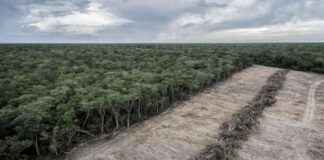Climate Change Affecting Nutrient Levels in Plants, Impacting Herbivores
In a world where more than a third of animals are herbivores, the struggle to meet energy needs through plant consumption is real. The issue is further exacerbated by the effects of climate change, which are diminishing the nutritional value of crucial foods for plant-eating populations worldwide.
The root of the problem lies in human activities, particularly the emission of fossil fuels that contribute to the rise in atmospheric carbon dioxide levels. As a result, global temperatures are increasing, prompting plants to grow faster in various ecosystems. While this ‘greening of the Earth’ may seem positive in terms of carbon storage, it comes with a downside—plants are becoming less nutrient-dense.
Research biologist Ellen Welti, associated with the Smithsonian Institution’s Great Plains Science Program, highlighted the repercussions of nutrient dilution on species across the food chain. From giant pandas to grasshoppers, plant-feeding populations are facing the brunt of these changes.
Expert Insights: Understanding the Future Impact
According to Alex Ruane, co-director of NASA’s Goddard Institute for Space Studies’ Climate Impacts Group, future climate change is not just about sporadic heat waves. It’s a gradual, daily process that intensifies extreme weather events and affects plant physiology significantly. This long-term shift in climate patterns poses a unique challenge to herbivores dependent on nutrient-rich plants for survival.
Welti emphasized the subtle yet profound impact of declining plant nutritional value on animal populations. The reduced nutrient content not only affects the fitness of herbivores but also exposes them to increased risks from predators and other stressors.
Implications for Livestock and Wild Species
Livestock, such as cattle, are also grappling with declining protein concentrations in their feed due to nutrient dilution. This trend poses a threat to both livestock health and the livelihoods of ranchers who depend on healthy animals for sustenance.
Insects, crucial members of ecosystems, are not exempt from the effects of nutrient dilution. Leaf-chewing insect species like caterpillars and grasshoppers are experiencing negative consequences, including smaller body sizes and reduced reproductive capabilities. On the other hand, insects like cicadas and aphids might benefit from carbon-rich plants, highlighting the complex interplay between species and their food sources.
The Need for Further Research
As we navigate these changing dynamics in plant nutrition and ecosystem health, Welti stressed the importance of ongoing research to understand the broader implications on entire food webs. Exploring how rising carbon dioxide levels alter plant species, affect predator-prey relationships, and reshape ecosystems is crucial for devising sustainable solutions to mitigate the impact of nutrient dilution on herbivores and other wildlife.
In essence, the evolving landscape of nutrient levels in plants is a silent but significant driver of ecological shifts, with far-reaching consequences for biodiversity and ecosystem resilience. By shedding light on this underappreciated aspect of climate change, we can take proactive steps to safeguard our planet’s delicate balance of life.
Subscribe to our newsletter for exclusive updates on environmental issues and solutions. Join us in our mission to protect the planet for future generations.
Cristen, a passionate writer and environmental advocate, reminds us that every action we take today shapes the world we leave behind for tomorrow. Through awareness and collective action, we can pave the way for a sustainable future where all living beings thrive in harmony with nature.














